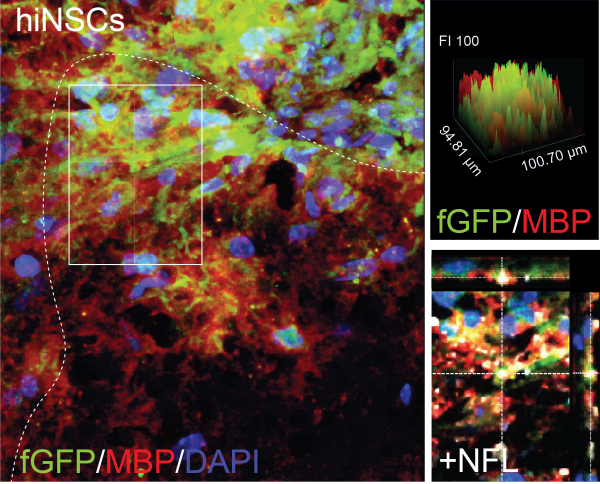Reviewed by Lexie CornerJul 8 2025
Researchers at Cambridge led a study showing that neural stem cell grafts may support myelin repair in the central nervous system. The results suggest that stem cell-based approaches could be a potential treatment for chronic demyelinating conditions, including progressive multiple sclerosis.
 Confocal microscopy image highlighting the repair of nerve insulation (myelin) in spinal cord lesions after stem cell treatment. The left side uses green to show the location of stem cells and red to show myelin (MBP). On the right, the top graph shows the amount of myelin, and the bottom shows the nerve structure, indicating how well the insulation is reforming. Image Credit: University of Cambridge
Confocal microscopy image highlighting the repair of nerve insulation (myelin) in spinal cord lesions after stem cell treatment. The left side uses green to show the location of stem cells and red to show myelin (MBP). On the right, the top graph shows the amount of myelin, and the bottom shows the nerve structure, indicating how well the insulation is reforming. Image Credit: University of Cambridge
Multiple sclerosis (MS) is an autoimmune disorder in which the immune system mistakenly attacks the central nervous system. This leads to the breakdown of myelin, the protective layer surrounding nerve fibers. Myelin loss is a major cause of neurological disability in young adults.
In the early stages of MS, some cells can partially repair the damage by generating new myelin. However, this repair ability decreases significantly in the later, chronic phase of the disease. Reduced myelin regeneration contributes to greater nerve damage and worsening symptoms in people with progressive MS.
Although current treatments have improved, most therapies focus on managing symptoms. They do not stop or reverse the underlying damage or neurodegeneration. This underlines the need for a deeper understanding of MS progression and the potential role of stem cell-based therapies.
Dr. Luca Peruzzotti-Jametti from the University of Cambridge led the study, which was published in the journal Brain. It explores the potential of neural stem cell transplantation for treating progressive MS. While these transplants may help repair damage in the central nervous system, researchers continue to study their limitations.
The team used induced neural stem cells (iNSCs) in a mouse model to test their ability to support remyelination. For the first time, they showed that iNSC grafts can develop into oligodendrocytes - cells that produce myelin. The study also provided evidence supporting the safety of transplanting human-induced brain stem cells.
This research provides critical evidence that induced neural stem cell grafts can effectively turn into myelin-producing cells within the damaged central nervous system, suggesting a potential new way to treat progressive MS.
Dr. Peruzzotti-Jametti, Study First Author, Department of Clinical Neurosciences, University of Cambridge
The research team is investigating the underlying mechanisms of MS in the central nervous system. They are also studying how neural stem cell-based therapies might influence neuroprotective and anti-inflammatory responses. The goal is to understand how these treatments could slow brain atrophy and disease progression.
Our findings represent a significant step forward in understanding how stem cell therapies can be harnessed to combat chronic demyelinating disorders. We are particularly excited about the potential to develop central nervous system-directed therapies that not only manage symptoms but also address the underlying neurodegenerative processes in progressive MS.
Stefano Pluchino, Study Senior Author and Clinical Professor, Department of Clinical Neurosciences, University of Cambridge
Stefano Pluchino added, “We have shown we can make new myelin with stem cells, and demonstrated it is possible to target lesions with grafts. This is a major step forward in the research towards directed therapies for chronic demyelinating disorders such as progressive multiple sclerosis.”
Dr Catherine Godbold, Senior Research Communications Manager at MS Society, added, “More than 150,000 people live with MS in the UK, and it can be debilitating, exhausting, and unpredictable. Neural stem cell therapy for MS is still in the very early stages of research, but these results with mice are invaluable. They help us understand how neural stem cells might one day be able to unlock desperately needed myelin-repair treatments. We are proud to have supported this study and hope it can bring us another step closer to stopping progression for everyone with MS.”
Future Research and RESTORE
The study provides clear evidence that neural stem cell grafts can generate new myelin in vivo in animal models with MS-like lesions. This finding has important implications for future research and clinical development.
Several leading researchers at the University of Cambridge, including Prof. Stefano Pluchino and Dr. Luca Peruzzotti-Jametti, are part of the RESTORE project. This European and U.S. collaboration focuses on developing new stem cell therapies for people with progressive multiple sclerosis.
RESTORE is supported by the International Progressive MS Alliance through its Experimental Medicine Development Award Scheme 2025. Its objective is to launch a clinical trial using neural stem cell-based therapy for progressive MS.
A core part of the project’s approach is to involve people with MS in the research process. This helps ensure that the work reflects their needs, values, and perspectives.
In addition to showing that neural stem cell transplants can promote remyelination and improve neurological outcomes, the trial will guide future research. The results are expected to support better clinical trial design and help advance the development of a fully biological, disease-modifying treatment for progressive MS.
“We will be working with our partner researchers worldwide across the RESTORE research consortium to directly put the findings of this study into further practice, and to explore the potential for a neural stem cell graft clinical trial in the future,” stated Professor Pluchino.
Source:
Journal reference:
Peruzzotti-Jametti, L., et al. (2025) Remyelination of chronic demyelinated lesions with directly induced neural stem cells. Brain. doi.org/10.1093/brain/awaf208.